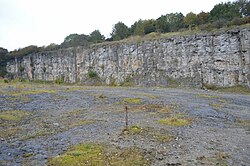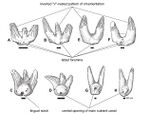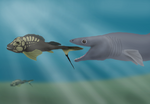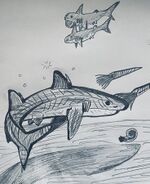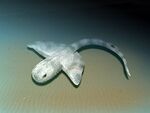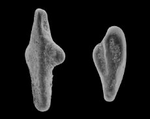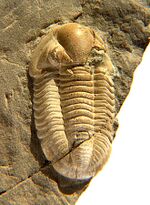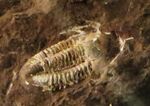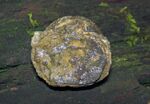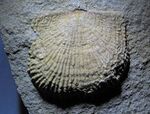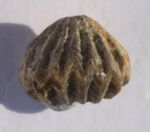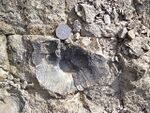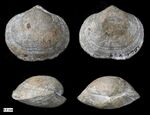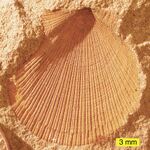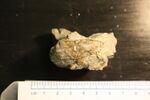(diff) ← Older revision | Latest revision (diff) | Newer revision → (diff)
Short description: Geologic formation in England
The Eyam Limestone (formerly known as the Cawdor Group, Cawdor Limestone or Eyam Group) is a geologic formation in the Peak District, England . It preserves fossils dating back to the Viséan stage of the Carboniferous period, and represents a marine environment.[2]
Depositional environment
At the time of deposition, Britain was just south of the equator (<5° S) and part of the Euramerica continent. Study of the growth rings of fossil wood from other localities indicate that the British Isles had a monsoonal climate during the early Carboniferous, with tropical rainfall seasonality.[3] The Eyam Limestone was deposited on an extensive, thick carbonate ramp and platform on the northeast margin of the Widmerpool Gulf (an extensive basin which existed as an area of open water during the time of deposition). Reefs and their associated fore-reef and lagoonal environments are represented in the Eyam Limestone, with crinoids dominating the reef and providing habitats for other animals. The presence of photosymbiotic coral and micritic envelopes on some crinoid ossicles indicates the formation was deposited within the photic zone in a marine environment of normal salinity. The presence of the xenacanth Bransonella has been suggested to imply freshwater influence as xenacanths live mainly in freshwater habitats, however its presence in other marine formations suggests that Bransonella was a marine animal unlike its relatives.[1]
Apatite crystals formed by the recrystallization of phosphatic overgrowths are present on some conodont elements from the formation. As phosphatogenesis only occurs in the anoxic-oxic boundary while apatite precipitation occurs in the top few centimeters of the sediment column, this reveals that shallow sediment with low geothermal temperatures and dysoxic conditions were present in the Eyam Limestone.[1][4]
Fossil content
Cartilaginous fish
Conodonts
Invertebrates
Arthropods
Brachiopods
| Brachiopods reported from the Eyam Limestone
|
| Genus |
Species |
Presence
|
Material |
Notes |
Images
|
| Acanthoplecta
|
A. mesoloba
|
Monyash.[10]
|
|
A productid.
|
|
| Alitaria
|
A.? panderi
|
Monyash.[10]
|
|
A productid.
|
|
| A. sp.
|
Monyash.[10]
|
|
A productid.
|
|
| Antiquatonia
|
A. hindi
|
Monyash.[10]
|
|
A productid.
|
|
| A. cf. hindi
|
Monyash.[10]
|
|
A productid.
|
|
| A. cf. insculpta
|
Monyash.[10]
|
|
A productid.
|
|
| A. sulcata
|
Monyash.[10]
|
|
A productid.
|
|
| A. sp.
|
Monyash.[10]
|
|
A productid.
|
|
| Avonia
|
A. aculeata
|
Monyash.[10]
|
|
A productid.
|
|
| A. davidsoni
|
Monyash.[10]
|
|
A productid.
|
|
| A. youngiana
|
Monyash.[10]
|
|
A productid.
|
|
| A. cf. youngiana
|
Monyash.[10]
|
|
A productid.
|
|
| A. sp.
|
Monyash.[10]
|
|
A productid.
|
|
| Brachythyris
|
B. ovalis
|
Monyash.[10]
|
|
A spiriferid.
|
|
| B. cf. ovalis
|
Monyash.[10]
|
|
A spiriferid.
|
|
| Buxtonia
|
B. sp.
|
Monyash.[10]
|
|
A productid.
|
|
| Coledium
|
C. sp.
|
Monyash.[10]
|
|
A rhynchonellid.
|
|
| Dictyoclostus
|
D. sp.
|
Monyash.[10]
|
|
A productid.
|
|
| Echinoconchus
|
E. punctatus
|
Monyash.[10]
|
|
A productid.
|
|
| E. subelegans
|
Monyash.[10]
|
|
A productid.
|
|
| Eomarginifera
|
E. cf. lobata
|
Monyash.[10]
|
|
A productid.
|
|
| E. longispinus
|
Monyash.[10]
|
|
A productid.
|
|
| Fluctuaria
|
F. undata
|
Monyash.[10]
|
|
A productid.
|
|
| Fusella
|
F. sp.
|
Monyash.[10]
|
|
A spiriferid.
|
|
| Girtyella
|
G. sacculus
|
Monyash.[10]
|
|
A terebratulid.
|
|
| Hustedia
|
H. ulothrix
|
Monyash.[10]
|
|
An athyridid.
|
|
| Kochiproductus
|
K. sp.
|
Monyash.[10]
|
|
A productid.
|
|
| Krotovia
|
K. spinulosa
|
Monyash.[10]
|
|
A productid.
|
|
| Linoproductoidea indet.
|
Indeterminate
|
Monyash.[10]
|
|
A productid.
|
|
| Linoprotonia
|
L. sp.
|
Monyash.[10]
|
|
A productid.
|
|
| Marginicinctus
|
M. sp.
|
Monyash.[10]
|
|
A productid.
|
|
| Marginiferoidea indet.
|
Indeterminate
|
Monyash.[10]
|
|
A productid.
|
|
| Martinia
|
M. sp.
|
Monyash.[10]
|
|
A spiriferid.
|
|
| Orthoidea indet.
|
Indeterminate
|
Monyash.[10]
|
|
An orthid.
|
|
| Overtonia
|
O. fimbriata
|
Monyash.[10]
|
|
A productid.
|
|
| Pleuropugnoides
|
P. pleurodon
|
Monyash.[10]
|
|
A rhynchonellid.
|
|
| P. sp.
|
Monyash.[10]
|
|
A rhynchonellid.
|
|
| Productina
|
P. margaritacaea
|
Monyash.[10]
|
|
A productid.
|
|
| P. sp.
|
Monyash.[10]
|
|
A productid.
|
|
| Productus
|
P. productus
|
Monyash.[10]
|
|
A productid.
|
|
| P. sp.
|
Monyash.[10]
|
|
A productid.
|
|
| Pugilis
|
P. cf. pugilis
|
Monyash.[10]
|
|
A productid.
|
|
| P. sp.
|
Monyash.[10]
|
|
A productid.
|
|
| Pugnax
|
P. acuminatus
|
Monyash.[10]
|
|
A rhynchonellid.
|
|
| P. codiformis
|
Monyash.[10]
|
|
A rhynchonellid.
|
|
| P. pseudopugnus
|
Monyash.[10]
|
|
A rhynchonellid.
|
|
| P. cf. pugnoides
|
Monyash.[10]
|
|
A rhynchonellid.
|
|
| P. sp.
|
Monyash.[10]
|
|
A rhynchonellid.
|
|
| Pustula
|
P. sp.
|
Monyash.[10]
|
|
A productid.
|
|
| Rugosochonetes
|
R. sp.
|
Monyash.[10]
|
|
A productid.
|
|
| Schizophoria
|
S. resupinata
|
Monyash.[10]
|
|
An orthid.
|
|
| S. sp.
|
Monyash.[10]
|
|
An orthid.
|
|
| Sinuatella
|
S. cf. sinuata
|
Monyash.[10]
|
|
A productid.
|
|
| S. sp.
|
Monyash.[10]
|
|
A productid.
|
|
| Spirifer
|
S. bisulcatus
|
Monyash.[10]
|
|
A spiriferid.
|
|
| S. cf. bisulcatus
|
Monyash.[10]
|
|
A spiriferid.
|
|
| S. planicostus
|
Monyash.[10]
|
|
A spiriferid.
|
|
| S. triangularis
|
Monyash.[10]
|
|
A spiriferid.
|
|
| Spiriferoidea indet.
|
Indeterminate
|
Monyash.[10]
|
|
A spiriferid.
|
|
Bryozoans
| Bryozoans reported from the Eyam Limestone
|
| Genus |
Species |
Presence
|
Material |
Notes |
Images
|
| Fenestelloidea
|
Indeterminate
|
Monyash.[10]
|
|
|
|
Cnidarians
| Cnidarians reported from the Eyam Limestone
|
| Genus |
Species |
Presence
|
Material |
Notes |
Images
|
| Diphyphyllum
|
D. sp.
|
Monyash.[10]
|
|
A horn coral.
|
|
Echinoderms
| Echinoderms reported from the Eyam Limestone
|
| Genus |
Species |
Presence
|
Material |
Notes |
Images
|
| Crinoidea indet.
|
Indeterminate
|
Monyash.[10]
|
|
|
|
Molluscs
See also
- List of fossiliferous stratigraphic units in England
References
- ↑ 1.00 1.01 1.02 1.03 1.04 1.05 1.06 1.07 1.08 1.09 1.10 1.11 1.12 1.13 1.14 1.15 1.16 1.17 1.18 1.19 1.20 1.21 1.22 1.23 1.24 1.25 1.26 1.27 1.28 1.29 1.30 1.31 1.32 1.33 1.34 1.35 1.36 1.37 1.38 1.39 1.40 1.41 1.42 Smith, Roy; Martill, David M.; Duffin, Christopher (2017-06-01). "The shark-beds of the Eyam Limestone Formation (Lower Carboniferous, Viséan) of Steeplehouse Quarry, Wirksworth, Derbyshire, UK". Proceedings of the Geologists' Association 128 (3): 374–400. doi:10.1016/j.pgeola.2017.04.004. ISSN 0016-7878. https://www.academia.edu/33671880.
- ↑ 2.0 2.1 "BGS Lexicon of Named Rock Units - Result Details". https://webapps.bgs.ac.uk/lexicon/lexicon.cfm?pub=EYL.
- ↑ Falcon-Lang, H. J. (March 1999). "The Early Carboniferous (Courceyan–Arundian) monsoonal climate of the British Isles: evidence from growth rings in fossil woods" (in en). Geological Magazine 136 (2): 177–187. doi:10.1017/S0016756899002307. ISSN 0016-7568. https://www.researchgate.net/publication/41816712.
- ↑ Sanz-López, Javier; Blanco-Ferrera, Silvia (2012-10-01). "Overgrowths of large authigenic apatite crystals on the surface of conodonts from Cantabrian limestones (Spain)" (in en). Facies 58 (4): 707–726. doi:10.1007/s10347-012-0295-3. ISSN 1612-4820. https://doi.org/10.1007/s10347-012-0295-3.
- ↑ 5.0 5.1 5.2 5.3 Duffin, Christopher; Ward, David (1983-01-01). "Neoselachian sharks' teeth from the Lower Carboniferous of Britain and the Lower Permian of the USA". Palaeontology. https://www.academia.edu/2891464.
- ↑ 6.00 6.01 6.02 6.03 6.04 6.05 6.06 6.07 6.08 6.09 6.10 6.11 6.12 6.13 6.14 6.15 Ginter, Michał; Duffin, Christopher; Dean, Mark; Korn, Dieter (2014). "Late Viséan pelagic chondrichthyans from northern Europe". Acta Palaeontologica Polonica. doi:10.4202/app.00084.2014. https://www.researchgate.net/publication/274774718.
- ↑ 7.0 7.1 Cuny, Gilles (2008-01-01). "Carcharopsis prototypus and the adaptations of single crystallite enameloid in cutting dentitions". Acta Geologica Polonica. https://www.academia.edu/1391669.
- ↑ 8.0 8.1 Duffin, Christopher J.; Ward, David J. (2017-07-19). "A new janassid petalodont chondrichthyan from the Early Carboniferous of Derbyshire, UK" (in en). Proceedings of the Geologists' Association 128 (5–6): 809–814. doi:10.1016/j.pgeola.2017.06.008. https://www.researchgate.net/publication/318544690.
- ↑ Duffin, C. (1985). "Revision of the hybodont selachian genus Lissodus BROUGH (1935)". Palaeontographica Abteilung A-palaozoologie-stratigraphie.
- ↑ 10.00 10.01 10.02 10.03 10.04 10.05 10.06 10.07 10.08 10.09 10.10 10.11 10.12 10.13 10.14 10.15 10.16 10.17 10.18 10.19 10.20 10.21 10.22 10.23 10.24 10.25 10.26 10.27 10.28 10.29 10.30 10.31 10.32 10.33 10.34 10.35 10.36 10.37 10.38 10.39 10.40 10.41 10.42 10.43 10.44 10.45 10.46 10.47 10.48 10.49 10.50 10.51 10.52 10.53 10.54 10.55 10.56 10.57 10.58 10.59 10.60 10.61 10.62 10.63 10.64 10.65 10.66 10.67 10.68 10.69 10.70 10.71 Gutteridge, P. (May 1990). "The origin and significance of the distribution of shelly macrofauna in late Dinantian carbonate mud mounds of Derbyshire" (in en). Proceedings of the Yorkshire Geological Society 48 (1): 23–32. doi:10.1144/pygs.48.1.23. ISSN 0044-0604. https://www.lyellcollection.org/doi/10.1144/pygs.48.1.23.
- ↑ 11.0 11.1 11.2 11.3 Tilsley, J. W. (December 1988). "New data on Carboniferous (Dinantian) trilobites from the Peak District, Derbyshire, England" (in en). Proceedings of the Yorkshire Geological Society 47 (2): 163–176. doi:10.1144/pygs.47.2.163. ISSN 0044-0604. https://www.researchgate.net/publication/249557212.
 | Original source: https://en.wikipedia.org/wiki/Eyam Limestone. Read more |
